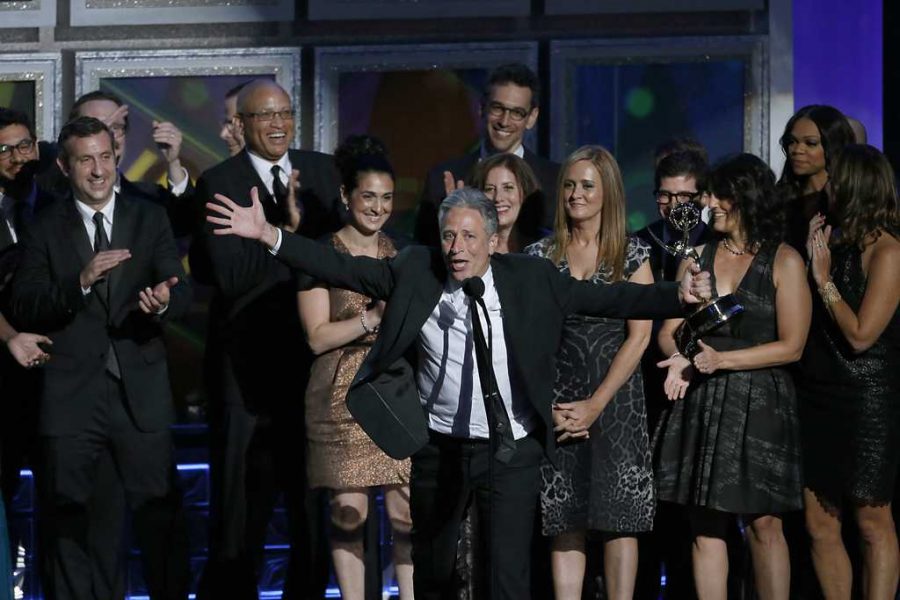Samantha Bee may become the first woman in late-night television this week, but she’s also extending the genre’s latest trend — emulating Jon Stewart.
While the state of late-night talk shows is unsurprising, what is surprising is that almost half of all late night talk shows lead back to one man: Stewart. He left a void in comedy and journalism with his departure from “The Daily Show,” but his influence on television is more apparent than ever.
The next “Daily Show” alumna to head an individual project — while simultaneously “breaking up the boys” club of late-night television — is Bee’s “Full Frontal,” which airs on TBS Feb. 8. As the only current female late-night host, Bee will continue a lasting tradition of “Daily Show” alumni by borrowing the field-piece format she perfected on “The Daily Show.”
Bee joins a genre saturated with “Daily Show” alums who have moved on to other curators of late-night television. From format to material, hosts John Oliver, Larry Wilmore and Stephen Colbert are drawing inspiration from their time on Stewart’s show.
The British Invasion
“Last Week Tonight with John Oliver” reminds people of Stewart, perhaps because Oliver went from correspondent to host briefly last summer while Stewart filmed his directorial debut “Rosewater.”
As perhaps Stewart’s most effective heir, media outlets have coined the phrase “The John Oliver Effect” to describe a subject’s rising popularity or an issue’s solution after airing on “Last Week Tonight.”
By confronting the American population, in an often obscenity-laced tirade, about international stories and frustratingly solvable yet mundane domestic issues — such as net neutrality, U.S. territories and chicken farmers — “Last Week Tonight” has streamlined the “satirical journalism” format the Stewart-era “The Daily Show” molded in 1999.
This reputation, facilitated by HBO’s FCC-exempt private subscription system, results in Oliver’s now–familiar breakdown of complicated issues into comedic but didactic essay-sized segments, distinct from any other late-night show on television that talks politics.
The Brother
After a year of “The Nightly Show,” Wilmore has found his niche and thrives in it. “The Nightly Show” arrived alongside Stewart’s “Daily Show” exit, and rose during America’s recent racial tensions. As a result, Wilmore’s show resembles an extension of Stewart’s oft-recorded frustration with systemic racism.
Wilmore has used his platform as a black host to discuss many injustices and mirror public outrage, usually over racial issues, including a piece last week in which physicist poster boy Neil deGrasse Tyson slammed rapper and flat Earth truther B.o.B.
Perhaps because of controversial events like this rapper-physicist smackdown, he has filled the void of television’s “wise angry old man” that Stewart left.
The “wise” moniker may seem overly generous, but then you may remember that “The Nightly Show” basically predicted the #OscarsSoWhite backlash with their piece, “A Preview of Upcoming Black Oscar Snubs,” which aired the night before the Academy announced the nominees.
The Young Gun
Trevor Noah has had an easy first four months on Stewart’s old throne, delivering punchlines with a grin and a giggle. He’s only recently made tweaks to the show’s format — the first of which is a remixed theme song by hip-hop producer Timbaland. Other changes include standing story pieces — in which Noah literally stands as he talks instead of traditionally sitting behind the desk — and what could be termed “explainer” pieces — in which the show’s correspondents outline a particular part of the political process, whether it be post-debate fact-checking or political ad analysis — to the fresh citizen and host.
Noah’s tenure hasn’t impressed everyone. Slate called him out in January for shying away from real issues and instead going for the cheap laughs, similar to an early Stewart doing Clinton-affair jokes.
But it took Stewart years to make the show his own after taking over for Craig Kilborn in 1999 when it focused on pop culture and maintained a local-news aesthetic.
Noah may have Stewart’s writers and his time slot, but he doesn’t have his spirit — at least not yet.
The Prodigal Son
Colbert may never outshine the conservative character he created for “The Colbert Report,” but he didn’t cut ties with the satirical performance when he began “The Late Show” either. His take on David Letterman’s magnum opus is both a tribute to his political segments on the “Report” — and therefore Stewart — and the silliness that his legendary predecessor, Letterman, practically patented.
His desk pieces are cuts from the “Report” without the overly conservative twist, but he shines when covering the 2016 election, especially his “Hungry for Power Games,” a recurring segment where he covers the presidential election if it were the post-apocalyptic Hunger Games.
The rest of his show is filled with Letterman-branded comedy that comes from the desperation of writing for five nights a week — Big Furry Hat, anyone?
Though Colbert also got his start from Stewart, his “Late Show” is, understandably, where the influence is felt the least.
The Outcome
The state of late night post-Stewart may result in nights where hosts are doing different versions of the same joke, but that is the only real downfall. A recent deal with HBO will also see Stewart return to television, making digital timely content that will be shorter and less frequent than a full fledged TV show —more like condensed “Daily Show” episodes— for the program during the next four years.
With the current state of politics, we may need “satirical journalists” in our political discourse now more than ever.


